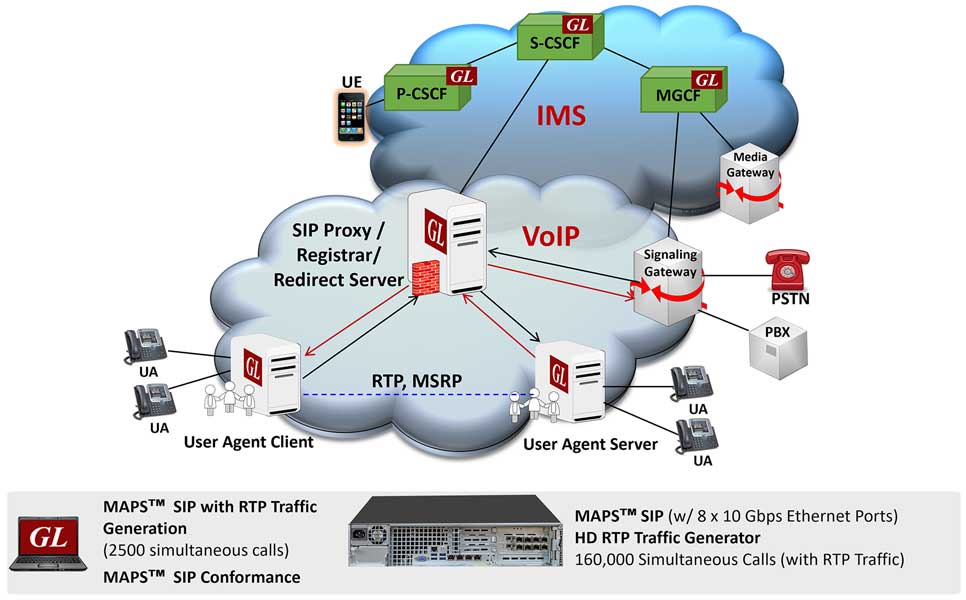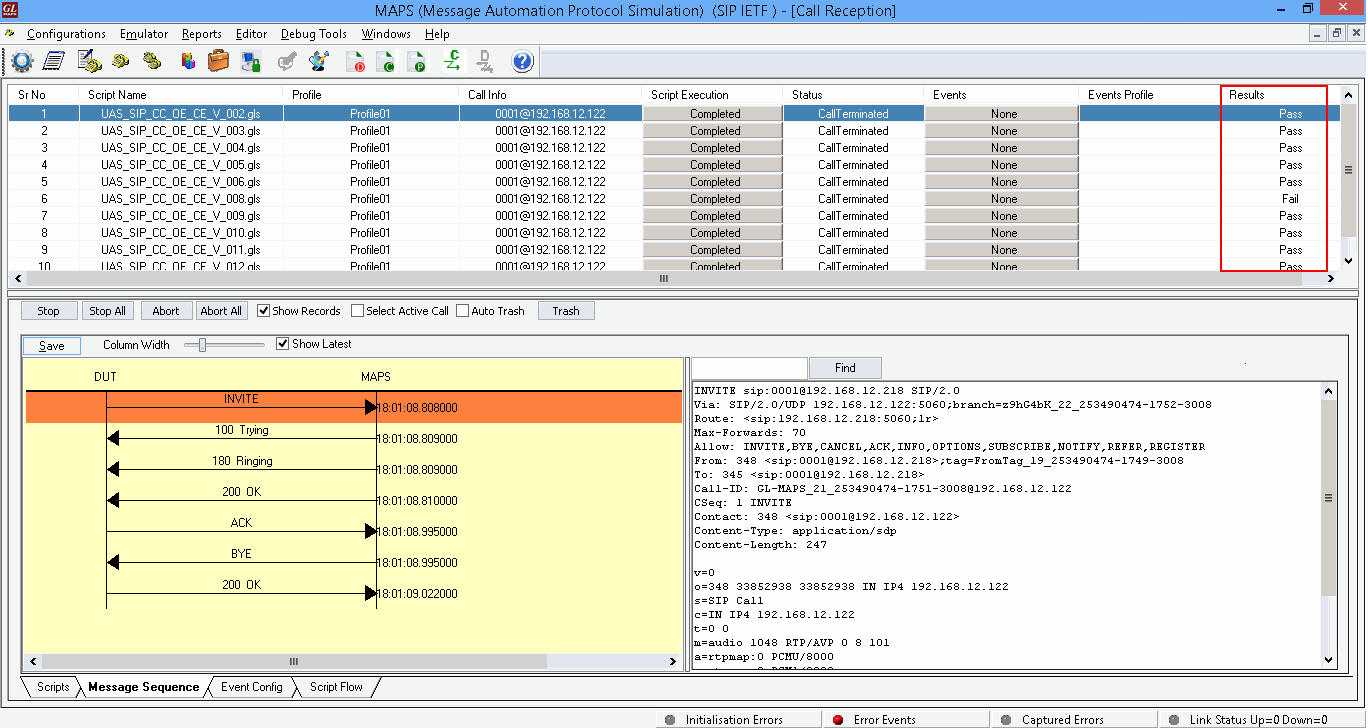Advanced SIP Emulation and Conformance Solution for VoIP Networks
Welcome to the latest issue of GL's Newsletter providing insight into our SIP protocol emulation and testing solutions.

Overview
GL's Message Automation & Protocol Simulation (MAPS™) is a versatile software program that can emulate a wide variety of telecommunications protocols. MAPS™ for SIP can emulate User Agents (User Agent Client - UAC, User Agent Server - UAS), Proxy, Redirect, Registrar, and Registrant servers.
This tool can place and answer calls, replicating the behavior of an actual VoIP phone. All call parameters are customizable, including calling number, called number, duration, audio payload, and more. Additionally, MAPS™ SIP seamlessly integrates with the MAPS™ RTP HD hardware appliance to generate tens of thousands of simultaneous calls through specialized Network Interface Cards.
SIP Testing
MAPS™ SIP can emulate any interface within the VoIP network. A single MAPS™ instance can function as multiple SIP entities simultaneously, generating various SIP messages on the wire in the VoIP network and consequently reducing the equipment required for testing. Additionally, it supports VoIP implementation following ED-137C of the EUROCAE standard, emulating both the Controller Working Group and Radio Media Gateway System for Air Traffic Control networks.
Designed for the comprehensive evaluation of Gateway/ATA products, our SIP testing solution covers areas such as call connectivity, call signaling, traffic generation, voice quality testing, codec functionality, and a myriad of other features. The tool facilitates the transmission and detection of various RTP traffic types, including digits, voice files, pass-through FAX, single tones, and dual tones. MAPS™ SIP can generate 2000 simultaneous RTP media calls at a rate of 250 calls per second (CPS). Furthermore, the application can scale up to 70,000 concurrent calls at 750 CPS for SIP signaling-only calls.
The software supports a Command Line Interface (CLI) through a client-server model, enabling users to control all features via Python and Java APIs, facilitating seamless integration of MAPS™ SIP into automation frameworks or environments.
The software provides automated FAX call emulation and analysis for T.30 and T.38 FAX sessions and allows for efficient testing, analysis, and troubleshooting of FAX transmissions over IP.
The software integrates with the Message Session Relay Protocol (MSRP) for instant messaging over SIP sessions in NG9-1-1 networks, emulating SIP/MSRP User Agents. It supports NG9-1-1 calls, including IM Only, Audio and IM, and Video and IM Calls across multiple User Agents.
Additionally, MAPS™ SIP conducts Interactive Voice Response (IVR) testing, recognizing, and responding to voice prompts using DTMF digits or voice for automated IVR traversal.
MAPS™ SIP also emulates multimedia calls, including Audio, Video, and Instant Messaging, with pre-recorded audio/video transmitted using RTP and text messages exchanged via MSRP within the same call. This involves three media lines: one for Audio, one for Video, and another for text messages using MSRP.
Our SIP testing tool excels in emulating diverse interfaces in a SIP network (standard SIP, SIP-I (ISUP), SIP IMS, and SIP MSRP) and execute SIP Protocol Conformance Testing for varied SIP protocol implementations. The SIP protocol is also integral to ED-137, the next generation air traffic control system.
SIP Conformance Suite
GL’s MAPS™ SIP Conformance Suite has over 400 test cases aligned with SIP specifications from the European Telecommunications Standards Institute (ETSI) TS 102 027-2 V3.1.1 (2004-11). This suite adheres to the protocol standards essential for assessing the conformance of various SIP Server and Client entities. It encompasses built-in scripts tailored for Proxy, Redirect Server, Registrar, UAC, and UAS conformance, helping comprehensive testing by following the ETSI standard.

Test cases cover general messaging and call flow, for multimedia call session setup and control across IP networks. The testing process includes logging and reporting of pass/fail results. These cases meticulously verify conformance in areas such as registration, call control, proxies, and redirect servers.
- Manages strict routing and loose routing for requests routed through proxies
- Adheres to the Conformance Test Specification for SIP (IETF RFC 3261)
- UA behavior involves:
- User Agent Client (UAC) initiating requests
- User Agent Server (UAS) responding to requests
- Entities and their roles include:
- Redirect Server: User Agent Server redirecting requests
- Proxy: Making requests on behalf of other clients
- Registrar: Accepts REGISTER requests
- Registrant: Sends the REGISTER message
Key Features
- Generates and processes SIP valid and invalid messages
- Enhanced with updates to reinforce IP security measures for SIP calls
- Generates PCAP traces seamlessly for both SIP and RTP sessions
- Automates T.30 and T.38 FAX sessions, supporting FAX analysis in both GUI and CLI modes
- Efficient handling of RTP media on remote systems
- Provides options to log the sequence of SIP call messages along with their decoding for every call
- Automation for the auto call rejection feature, supporting sequential/random error codes
- Expanded capabilities to configure Display names for Contact, From, and To Headers
- Options for configuring INVITE Expiry, offering an alternative method for determining call progress timeout
- Supports IPv4 /IPv6 and transport over UDP and TCP, and TLS for secure transport
- Supports joining a conference call, unattended call transfer, attended call transfer, call hold, auto call rejection, early media, and silence packets generation
- Ability to implement IP Spoofing for any network like Class C, Class B, etc.
- Supports in dialog and out of dialog transactions for SUBSCRIBE, NOTIFY, OPTIONS, REFER, and INFO SIP methods
- Supports almost all industry-standard codec types - G.711 (mu-Law and A-Law), G.722, G.729, G.726, GSM, AMR, AMR -WB, EVRC, EVS, OPUS, SMV, iLBC, SPEEX, and more
- Supports Secure Real-time Transport Protocol
- Provides Voice Quality statistics such as MOS, Packet loss, and Jitter
- Supports both RTP G.711 Pass-Through FAX and T.38 emulation over IP
- Supports Short Message Service (SMS) over IP/ IP Multimedia Subsystem (IMS) communication, SMS is encapsulated in a SIP message and carried over IMS core network
 Back to Newsletter Index Page
Back to Newsletter Index Page